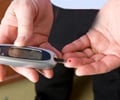Living near toxic waste may make you diabetic, says a study that tracked hospitalisation rates of patients in New York between 1993 and 2000.
Type-two diabetes has seen a two-fold increase - from 5.8 million to 13.3 million Americans from 1980 to 2002. While scientists scramble to find explanations for the rise, experts point to the obesity epidemic for the growing diabetes rate.However, the study by Lawrence Lessner and colleagues at the University at Albany here found that Americans who live near toxic waste sites are hospitalised more for diabetes than those who live in clean communities, reported UPI newswire.
The researchers compared hospitalisation rates by zip code for three types of communities: clean, without hazardous sites, contaminated by persistent organic pollutants and containing other types of waste or pollutants.
The study examined whites and blacks between the ages of 25 to 74, correcting for potential factors that could skew the data, such as age, race, sex and average household income.
Major types of organic pollutants are polychlorinated biphenyls, or PCBs, a former industrial ingredient of pesticides, paints, paper and other products.
Although banned from the US industries in the 1970s, PCBs still exist in the environment. People are mainly exposed through eating animal fats, although they can also breathe in the pollutants, said the study published in the January issue of monthly research journal Environmental Health Perspectives.
Advertisement
Although it is too early to draw conclusions about pollutants and diabetes, David Carpenter, director of the Institute for Health and the Environment at the University at Albany, said: "We should do whatever we can to reduce exposure to these compounds coming from waste sites."
Advertisement
SRM










